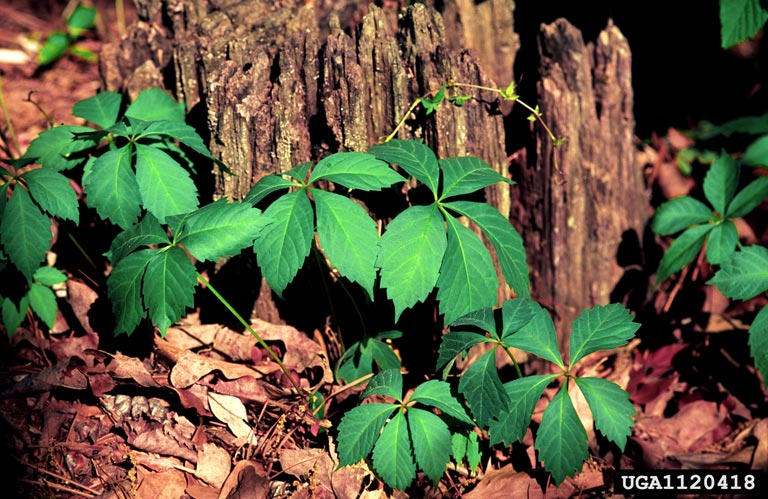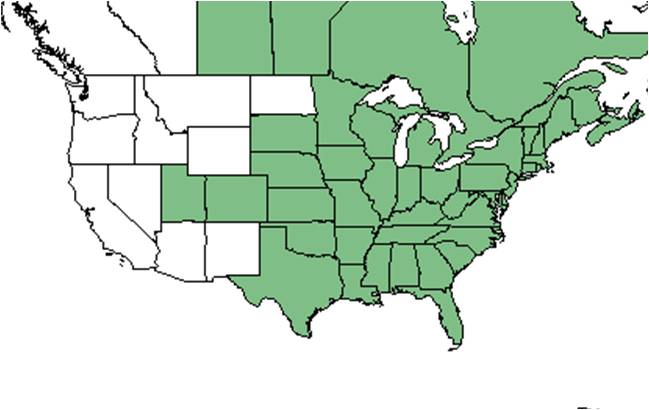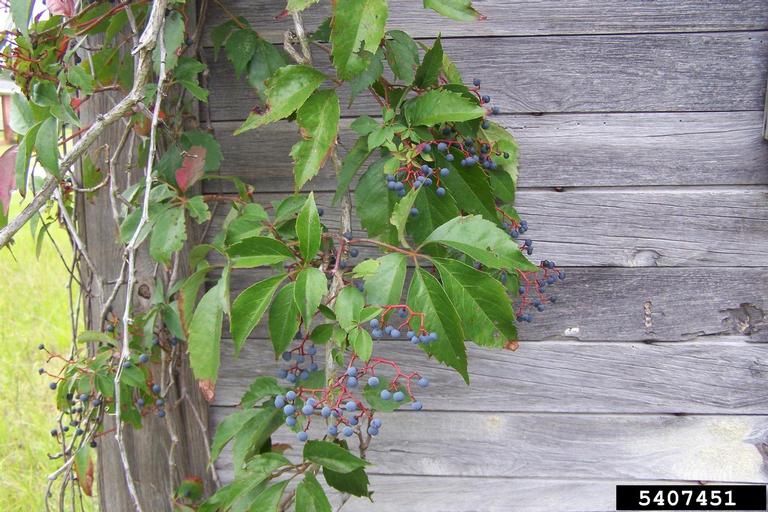Difference between revisions of "Parthenocissus quinquefolia"
Juliec4335 (talk | contribs) |
Emmazeitler (talk | contribs) |
||
| Line 20: | Line 20: | ||
Common name: Virginia creeper | Common name: Virginia creeper | ||
==Taxonomic notes== | ==Taxonomic notes== | ||
| − | + | Synonyms: ''Parthenocissus hirsuta'' (Pursh) Graebner<ref name="weakley">Weakley, A.S. 2015. Flora of the southern and mid-atlantic states. Working Draft of 21 May 2015. University of North Carolina at Chapel Hill, Chapel Hill, North Carolina.</ref> | |
| + | |||
| + | Varieties: none.<ref name="weakley">Weakley, A.S. 2015. Flora of the southern and mid-atlantic states. Working Draft of 21 May 2015. University of North Carolina at Chapel Hill, Chapel Hill, North Carolina.</ref> | ||
==Description== | ==Description== | ||
<!-- Basic life history facts such as annual/perrenial, monoecious/dioecious, root morphology, seed type, etc. --> | <!-- Basic life history facts such as annual/perrenial, monoecious/dioecious, root morphology, seed type, etc. --> | ||
| − | "High climbing vine with white pith and many tendrils with adhesive disks. Leaves palmately compound, petiolate; leaflets 3-7, usually 5, ovate, elliptic, or obovate, to 15 cm long and 8 cm wide, glabrous, usually pale beneath, occasionally pubescent, acuminate, coarsely serrate, usually above the middle of the blade, base cuneate or oblique, petiolulate. Inflorescence a panicle of cymes. Calyx flat, usually without lobes; petals 5, separate, yellowish green, 2-3 mm long; disk small, adnate to ovary; stamens 5, filaments short; style ca. 0.5 mm long. Drupes black or dark blue, globose, 5-9 mm in diam.; seeds 1-3, lustrous brown, planoconvex, obovoid, 3.5-4 mm long." <ref name=rad> Radford, Albert E., Harry E. Ahles, and C. Ritchie Bell. Manual of the Vascular Flora of the Carolinas. 1964, 1968. The University of North Carolina Press. 694. Print. </ref> | + | "High climbing vine with white pith and many tendrils with adhesive disks. Leaves palmately compound, petiolate; leaflets 3-7, usually 5, ovate, elliptic, or obovate, to 15 cm long and 8 cm wide, glabrous, usually pale beneath, occasionally pubescent, acuminate, coarsely serrate, usually above the middle of the blade, base cuneate or oblique, petiolulate. Inflorescence a panicle of cymes. Calyx flat, usually without lobes; petals 5, separate, yellowish-green, 2-3 mm long; disk small, adnate to ovary; stamens 5, filaments short; style ca. 0.5 mm long. Drupes black or dark blue, globose, 5-9 mm in diam.; seeds 1-3, lustrous brown, planoconvex, obovoid, 3.5-4 mm long."<ref name=rad> Radford, Albert E., Harry E. Ahles, and C. Ritchie Bell. Manual of the Vascular Flora of the Carolinas. 1964, 1968. The University of North Carolina Press. 694. Print. </ref> |
==Distribution== | ==Distribution== | ||
| Line 37: | Line 39: | ||
===Phenology=== <!--Timing off flowering, fruiting, seed dispersal, and environmental triggers. | ===Phenology=== <!--Timing off flowering, fruiting, seed dispersal, and environmental triggers. | ||
Cite PanFlora website if appropriate: http://www.gilnelson.com/PanFlora/ --> | Cite PanFlora website if appropriate: http://www.gilnelson.com/PanFlora/ --> | ||
| − | ''P. quinquefolia'' | + | ''P. quinquefolia'' flowers from May through July and fruits from July through August.<ref name="weakley">Weakley, A.S. 2015. Flora of the southern and mid-atlantic states. Working Draft of 21 May 2015. University of North Carolina at Chapel Hill, Chapel Hill, North Carolina.</ref>Leaves turn orange and red shades. Leaves are lost in cold winter weather. Flowering occurs from January through August in South Florida and April through June to the North. Fruiting occurs from June to November in South Florida and June to September to the North.<ref>Hall D. 1986 The Joy of Weeds-Florida's Wildflowers Virginia Creeper Palmetto 6(1):12</ref> |
===Seed dispersal=== | ===Seed dispersal=== | ||
| − | This species is thought to be dispersed by consumption by vertebrates. <ref>Kirkman, L. Katherine. Unpublished database of seed dispersal mode of plants found in Coastal Plain longleaf pine-grasslands of the Jones Ecological Research Center, Georgia.</ref> | + | This species is thought to be dispersed by consumption by vertebrates.<ref>Kirkman, L. Katherine. Unpublished database of seed dispersal mode of plants found in Coastal Plain longleaf pine-grasslands of the Jones Ecological Research Center, Georgia.</ref> |
<!--===Seed bank and germination===--> | <!--===Seed bank and germination===--> | ||
<!--===Fire ecology===--> <!--Fire tolerance, fire dependence, adaptive fire responses--> | <!--===Fire ecology===--> <!--Fire tolerance, fire dependence, adaptive fire responses--> | ||
===Pollination=== | ===Pollination=== | ||
| − | The following Hymenoptera families and species were observed visiting flowers of ''Parthenocissus quinquefolia'' at Archbold Biological Station: <ref name="Deyrup 2015">Deyrup, M.A. and N.D. 2015. Database of observations of Hymenoptera visitations to flowers of plants on Archbold Biological Station, Florida, USA.</ref> | + | The following Hymenoptera families and species were observed visiting flowers of ''Parthenocissus quinquefolia'' at Archbold Biological Station:<ref name="Deyrup 2015">Deyrup, M.A. and N.D. 2015. Database of observations of Hymenoptera visitations to flowers of plants on Archbold Biological Station, Florida, USA.</ref> |
Apidae: ''Apis mellifera'' | Apidae: ''Apis mellifera'' | ||
Revision as of 18:11, 2 October 2020
| Parthenocissus quinquefolia | |
|---|---|

| |
| Photo by James H. Miller & Ted Bodner, Southern Weed Science Society, Bugwood.org | |
| Scientific classification | |
| Kingdom: | Plantae |
| Division: | Magnoliophyta - Flowering plants |
| Class: | Magnoliopsida – Dicotyledons |
| Order: | Rhamnales |
| Family: | Vitaceae |
| Genus: | Parthenocissus |
| Species: | P. quinquefolia |
| Binomial name | |
| Parthenocissus quinquefolia (L.) Planch. | |

| |
| Natural range of Parthenocissus quinquefolia from USDA NRCS Plants Database. | |
Common name: Virginia creeper
Contents
Taxonomic notes
Synonyms: Parthenocissus hirsuta (Pursh) Graebner[1]
Varieties: none.[1]
Description
"High climbing vine with white pith and many tendrils with adhesive disks. Leaves palmately compound, petiolate; leaflets 3-7, usually 5, ovate, elliptic, or obovate, to 15 cm long and 8 cm wide, glabrous, usually pale beneath, occasionally pubescent, acuminate, coarsely serrate, usually above the middle of the blade, base cuneate or oblique, petiolulate. Inflorescence a panicle of cymes. Calyx flat, usually without lobes; petals 5, separate, yellowish-green, 2-3 mm long; disk small, adnate to ovary; stamens 5, filaments short; style ca. 0.5 mm long. Drupes black or dark blue, globose, 5-9 mm in diam.; seeds 1-3, lustrous brown, planoconvex, obovoid, 3.5-4 mm long."[2]
Distribution
The range is from Quebec and the Northeastern United States across to Minnesota, south to Texas, Florida, Cuba, Bermuda, and the Bahamas.[3]
Ecology
Habitat
It grows along fences in ditches, disturbed areas, moist hammocks and woods, and frequently occurs in rocky areas.[4] P. quinquefloia responds positively to soil disturbance by heavy silvilculture in North Carolina.[5] However, it does not respond to soil disturbance by clearcutting and chopping in North Florida flatwoods forests.[6]
Parthenocissus quinquefolia is an indicator species for the Calcareous Savannas community type as described in Carr et al. (2010).[7]
Phenology
P. quinquefolia flowers from May through July and fruits from July through August.[1]Leaves turn orange and red shades. Leaves are lost in cold winter weather. Flowering occurs from January through August in South Florida and April through June to the North. Fruiting occurs from June to November in South Florida and June to September to the North.[8]
Seed dispersal
This species is thought to be dispersed by consumption by vertebrates.[9]
Pollination
The following Hymenoptera families and species were observed visiting flowers of Parthenocissus quinquefolia at Archbold Biological Station:[10]
Apidae: Apis mellifera
Colletidae: Colletes nudus
Halictidae: Augochloropsis anonyma, A. metallica
Megachilidae: Coelioxys sayi, Megachile mendica
Pompilidae: Episyron conterminus posterus, Tachypompilus f. ferrugineus
Vespidae: Mischocyttarus cubensis, Parancistrocerus fulvipes rufovestris, P. perennis anacardivora, Polistes bellicosus, Stenodynerus beameri, Vespula squamosa
Conservation and management
Cultivation and restoration
Photo Gallery
Parthenocissus quinquefolia Photo by Karan A. Rawlins, University of Georgia, Bugwood.org
References and notes
- ↑ 1.0 1.1 1.2 Weakley, A.S. 2015. Flora of the southern and mid-atlantic states. Working Draft of 21 May 2015. University of North Carolina at Chapel Hill, Chapel Hill, North Carolina.
- ↑ Radford, Albert E., Harry E. Ahles, and C. Ritchie Bell. Manual of the Vascular Flora of the Carolinas. 1964, 1968. The University of North Carolina Press. 694. Print.
- ↑ Hall D. 1986The Joy of Weeds-Florida Wildflowers Virginia Creeper Palmetto 6(1):12
- ↑ Hall D. 1986 The Joy of Weeds-Florida's Wildflowers Virginia Creeper Palmetto 6(1):12
- ↑ Cohen, S., R. Braham, and F. Sanchez. (2004). Seed Bank Viability in Disturbed Longleaf Pine Sites. Restoration Ecology 12(4):503-515.
- ↑ Moore, W.H., B.F. Swindel, and W.S. Terry. (1982). Vegetative Response to Clearcutting and Chopping in a North Florida Flatwoods Forest. Journal of Range Management 35(2):214-218.
- ↑ Carr, S.C., K.M. Robertson, and R.K. Peet. 2010. A vegetation classification of fire-dependent pinelands of Florida. Castanea 75:153-189.
- ↑ Hall D. 1986 The Joy of Weeds-Florida's Wildflowers Virginia Creeper Palmetto 6(1):12
- ↑ Kirkman, L. Katherine. Unpublished database of seed dispersal mode of plants found in Coastal Plain longleaf pine-grasslands of the Jones Ecological Research Center, Georgia.
- ↑ Deyrup, M.A. and N.D. 2015. Database of observations of Hymenoptera visitations to flowers of plants on Archbold Biological Station, Florida, USA.
